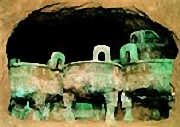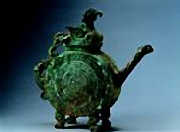 Location: Meixian County, Northwest China's Shaanxi Province
Location: Meixian County, Northwest China's Shaanxi Province
Period:Western Zhou Dynasty(1100-771BC)
Excavation period: January 2003
A joint team of researchers from the Shaanxi Provincial Archeological Research Institute, Baoji City Archeological Team and Meixian County Cultural Museum, led by Wang Zhankui
 Findings
Findings
On January 19, 2003, Chinese archaeologists unearthed abronze cache harvesting large quantities of inscribed bronze warefrom the Western Zhou Dynasty (11th century-711BC) in Yangjia Village, Meixian County of Baoji City, Northwest China's Shaanxi Province.
1) This bronze cache, which belonged to the famous Shan clan of the Western Zhou Dynasty, represents the first time that 27 bronze pieces have been unearthed in a single cache, each with engraved inscriptions. Among them are vessels used for rituals, drink and food that are large yet graceful in shape and decorated with complex patterns. They included 12dings (ancient cooking tripod vessels with two looped handles), onepan, two pots, nine calyxes, oneyu(a broad-mouthed receptacle for holding liquid), oneyi(gourd-shaped ladle) and onegui(a container for grain).
2) Archeologists were amazed by a bronze plate bearing a 350-character inscription that was longer than the inscriptions found on any bronze artifact excavated since 1949 -- even the 284-character inscription on the Shi QiangPan(water container) unearthed in Shaanxi Province in 1976.
It was considered by historians as the most important Western Zhou bronze item ever discovered. Inscriptions on the newly unearthed pan documented the 12 kings of the dynasty before King You who, as legend goes, led the dynasty to its downfall in his extravagant pursuit of luxuries and women. The list of kings checks out with the Shi Ji ("Records of the Great Historian") written by Han Dynasty(206 BC-AD220) historian Sima Qian.
3) In addition, each of the 12 bronze dings bears an unprecedented 300-word inscription. Even more importantly, these inscriptions list all of the 12 Western Zhou Dynasty kings (with the exception of the last king You) and provide information on various aspects of life and events during the Western Zhou Dynasty, which are invaluable to historical studies.
